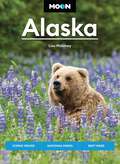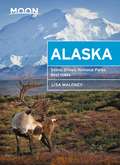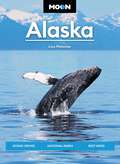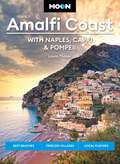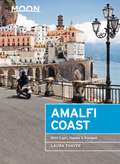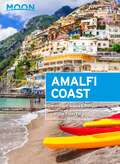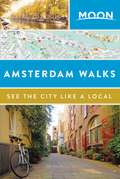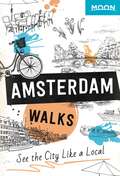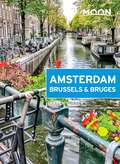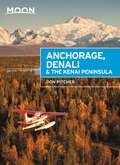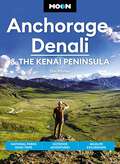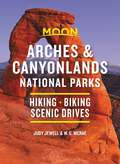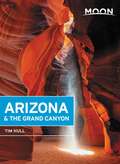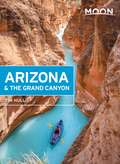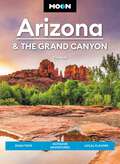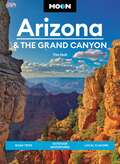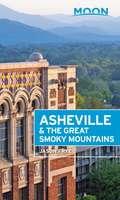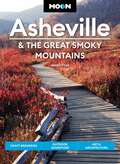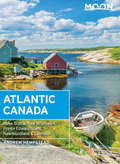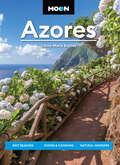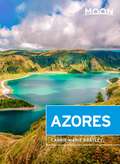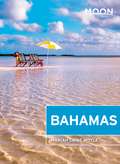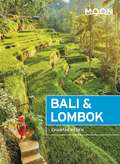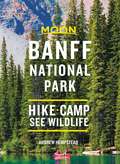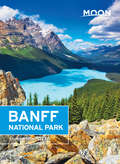- Table View
- List View
Moon Alaska: Scenic Drives, National Parks, Best Hikes (Moon U.S. Travel Guide)
by Lisa Maloney Moon Travel GuidesRemote, wild, and all-around otherworldly, Alaska promises unforgettable adventure. Discover the heart of "The Last Frontier" with Moon Alaska. Inside you'll find:Strategic itineraries, whether you have a week to hit the top sights or a month to explore the whole state The top outdoor activities: Embark on a glacier hike, cast your line in the halibut capital of the world, or take an intrepid "flightseeing" tour to secluded glacier landings in Denali National Park. Experience the thrill of spotting wild bears, moose, wolves, or even a walrus, or hop on a boat at Columbia Glacier to watch sea otters, harbor seals, and whales glide through the water. Kayak on tranquil sounds and secluded lakes or camp under a crystal-clear sky full of stars Unique experiences: Learn about Alaska Native cultures, visit quirky small towns, and discover the best spots to witness the enchanting northern lights Honest advice from Anchorage local and outdoor aficionado Lisa Maloney on when to go, what to pack, and where to stay, from campsites and hostels to B&Bs and resort fishing lodges Full-color photos and detailed maps throughout, plus a full-color foldout mapHow to get there and get around by plane, train, ferry, cruise ship, or guided tour Thorough background on the culture, climate, wildlife, local customs, and history, plus health and safety information With Moon Alaska's practical tips and expert insight, you can find your adventure. Headed to Canada? Try Moon Vancouver & Canadian Rockies Road Trip or Moon Victoria & Vancouver Island.About Moon Travel Guides: Moon was founded in 1973 to empower independent, active, and conscious travel. We prioritize local businesses, outdoor recreation, and traveling strategically and sustainably. Moon Travel Guides are written by local, expert authors with great stories to tell—and they can't wait to share their favorite places with you. For more inspiration, follow @moonguides on social media.
Moon Alaska: Scenic Drives, National Parks, Best Hikes (Travel Guide)
by Lisa MaloneyRemote, wild, and all-around otherworldly, Alaska promises unforgettable adventure. Discover the heart of "The Last Frontier" with Moon Alaska. Inside you'll find:Strategic itineraries, whether you have a week to hit the top sights or a month to explore the whole state, with ideas for outdoor adventurers, history buffs, road-trippers, wildlife enthusiasts, and moreThe top outdoor activities: Embark on a glacier hike, cast your line in the halibut capital of the world, or take an intrepid "flightseeing" tour to secluded glacier landings in Denali National Park. Experience the thrill of spotting wild bears, moose, wolves, or even a walrus, or hop on a boat at Columbia Glacier to watch sea otters, harbor seals, and whales glide through the water. Kayak on tranquil sounds and secluded lakes or camp under a crystal-clear sky full of starsUnique experiences: Learn about Alaska's native cultures, visit quirky small towns, and discover the best spots to witness the enchanting northern lightsHonest advice from Anchorage local and outdoor aficionado Lisa Maloney on when to go, what to pack, and where to stay, from campsites and hostels to B&Bs and resort fishing lodgesFull-color photos and detailed maps throughout, plus a full-color foldout mapHow to get there and get around by plane, train, ferry, cruise ship, or guided tourRecommendations for families, LGBTQ+ travelers, women traveling solo, seniors, international visitors, and travelers with disabilitiesThorough background on the culture, weather, wildlife, local laws, and history, plus tips for health and safetyWith Moon Alaska's practical tips and expert insight, you can find your adventure.Can't get enough of Alaska? Try Moon Anchorage, Denali & the Kenai Peninsula. Headed to Canada? Try Moon Vancouver & Canadian Rockies Road Trip or Moon Banff National Park.
Moon Alaska: Scenic Drives, National Parks, Best Hikes (Travel Guide)
by Lisa MaloneyRemote, wild, and all-around otherworldly, Alaska promises unforgettable adventure. Discover the heart of "The Last Frontier" with Moon Alaska. Inside you'll find:Strategic itineraries, whether you have a week to hit the top sights or a month to explore the whole state, with ideas for outdoor adventurers, history buffs, road-trippers, wildlife enthusiasts, and more The top outdoor activities: Embark on a glacier hike, cast your line in the halibut capital of the world, or take an intrepid "flightseeing" tour to secluded glacier landings in Denali National Park. Experience the thrill of spotting wild bears, moose, wolves, or even a walrus, or hop on a boat at Columbia Glacier to watch sea otters, harbor seals, and whales glide through the water. Kayak on tranquil lakes or camp under a crystal-clear sky full of stars Unique experiences: Learn about Alaska's native cultures, visit quirky small towns, and discover the best spots to witness the enchanting northern lights Honest advice from Anchorage local and outdoor aficionado Lisa Maloney on when to go, what to pack, and where to stay, from campsites and hostels to B&Bs and resort fishing lodges Full-color photos and detailed maps throughout, plus a full-color foldout mapHow to get there and get around by plane, train, ferry, cruise ship, or guided tour Thorough background on the culture, weather, wildlife, and history, plus health and safety tips With Moon Alaska's practical tips and expert insight, you can find your adventure. Headed to Canada? Try Moon Vancouver & Canadian Rockies Road Trip or Moon Banff National Park. About Moon Travel Guides: Moon was founded in 1973 to empower independent, active, and conscious travel. We prioritize local businesses, outdoor recreation, and traveling strategically and sustainably. Moon Travel Guides are written by local, expert authors with great stories to tell—and they can't wait to share their favorite places with you. For more inspiration, follow @moonguides on social media.
Moon Amalfi Coast: Best Beaches, Timeless Villages, Local Flavors (Moon Europe Travel Guide)
by Laura Thayer Moon Travel GuidesFrom the pastel rooftops of Positano to the soaring peak of Monte Solaro, immerse yourself in la dolce vita with Moon Amalfi Coast. Inside you'll find:Flexible itineraries for spending five to seven days on the Amalfi Coast, whether you want to island-hop in the Gulf of Naples or spend your days hiking and sunbathing in Amalfi Must-see highlights and unique experiences: Swim in turquoise waters, relax on sun-soaked beaches, or hop on a boat and cruise past cliffs, coves, and secret caves. Go underground to see ancient ruins in Naples or climb the towers of medieval castles. Take a day trip to Pompeii and hike to the top of Mount Vesuvius, ride a chairlift to the summit of Monte Solaro, or unwind in the natural hot springs that dot the island of Ischia The best local flavors: Stroll quiet village streets where the scent of Sunday ragù fills the air, feast on fresh seafood steps from the Mediterranean, sip local limoncello on a sunny terrace, and chow down on authentic Neapolitan pizza Honest suggestions from Amalfi local Laura Thayer on where to stay, what to eat, and how to get around Full-color photos and detailed maps throughoutBackground information on the landscape, history, and cultural customs of the Amalfi Coast Handy tools including an Italian phrasebook and tips for seniors and traveling with children With Moon Amalfi Coast's practical tips and local insight on the best things to see and do, you can experience the best of the Amalfi Coast. Exploring more of Italy? Check out Moon Southern Italy or Moon Rome, Florence & Venice.About Moon Travel Guides: Moon was founded in 1973 to empower independent, active, and conscious travel. We prioritize local businesses, outdoor recreation, and traveling strategically and sustainably. Moon Travel Guides are written by local, expert authors with great stories to tell—and they can't wait to share their favorite places with you. For more inspiration, follow @moonguides on social media.
Moon Amalfi Coast: With Capri, Naples & Pompeii (Travel Guide)
by Laura ThayerFrom the pastel rooftops of Positano to the soaring peak of Monte Solaro, immerse yourself in la dolce vita with Moon Amalfi Coast. Inside you'll find:Flexible itineraries for spending 1 to 5 days in different spots along the Amalfi Coast, including Sorrento, Capri, Naples, and more, that can be combined for a longer tripStrategic advice for foodies, art lovers, hikers, history buffs, beach bums, and moreMust-see highlights and unique experiences: Swim in turquoise waters, relax on sun-soaked beaches, or hop on a boat and cruise past cliffs, coves, and secret caves. Go underground to see ancient ruins in Naples or climb the towers of medieval castles. Take a day trip to Pompeii and hike to the top of Mount Vesuvius, ride a chairlift to the top of Monte Solaro, or unwind in the natural hot springs that dot the island of IschiaThe best local flavors: Stroll quiet village streets where the scent of Sunday ragu fills the air, feast on fresh seafood steps from the Mediterranean, sip local limoncello on a sunny terrace, and chow down on authentic Neapolitan pizzaHonest suggestions from Amalfi local Laura Thayer on where to stay, where to eat, and how to get aroundFull-color photos and detailed maps throughoutBackground information on the landscape, history, and cultural customs of the Amalfi CoastHandy tools including an Italian phrasebook and tips for seniors and traveling with childrenWith Moon Amalfi Coast's practical tips and local insight on the best things to do and see, you can experience the best of the Amalfi Coast.Exploring more of Italy? Check out Moon Milan & the Italian Lakes or Moon Rome, Florence & Venice.
Moon Amalfi Coast: With Capri, Naples & Pompeii (Travel Guide)
by Laura ThayerFrom the pastel rooftops of Positano to the soaring peak of Monte Solaro, immerse yourself in la dolce vita with Moon Amalfi Coast. Inside you'll find:Flexible itineraries for spending 1 to 5 days in different spots along the Amalfi Coast, including Sorrento, Capri, Naples, and more, that can be combined for a longer tripStrategic advice for foodies, art lovers, hikers, history buffs, beach bums, and moreMust-see highlights and unique experiences: Swim in turquoise waters, relax on sun-soaked beaches, or hop on a boat and cruise past cliffs, coves, and secret caves. Go underground to see ancient ruins in Naples or climb the towers of medieval castles. Take a day trip to Pompeii and hike to the top of Mount Vesuvius, ride a chairlift to the peak of Monte Solaro, or unwind in the natural hot springs that dot the island of IschiaThe best local flavors: Stroll quiet village streets where the scent of Sunday ragu fills the air, feast on fresh seafood steps from the Mediterranean, sip local limoncello on a sunny terrace, and chow down on authentic Neapolitan pizzaHonest suggestions from Amalfi local Laura Thayer on where to stay, where to eat, and how to get aroundFull-color photos and detailed maps throughoutHelpful resources on COVID-19 and traveling to the Amalfi CoastBackground information on the landscape, history, and cultural customs of the Amalfi CoastHandy tools including an Italian phrasebook and tips for seniors and traveling with childrenWith Moon Amalfi Coast's practical tips and local insight on the best things to do and see, you can experience the best of the Amalfi Coast.Exploring more of Italy? Check out Moon Milan & Beyond with the Italian Lakes or Moon Rome, Florence & Venice. About Moon Travel Guides: Moon was founded in 1973 to empower independent, active, and conscious travel. We prioritize local businesses, outdoor recreation, and traveling strategically and sustainably. Moon Travel Guides are written by local, expert authors with great stories to tell—and they can't wait to share their favorite places with you.For more inspiration, follow @moonguides on social media.
Moon Amsterdam Walks (Travel Guide)
by Moon Travel GuidesExperience Amsterdam like a local: on foot! Wander along Amsterdam's sparkling canals and bask in the diversity of its village vibes and cosmopolitan culture with Moon Amsterdam Walks. This full-color guide features: Six customizable walks through the city's hippest neighborhoods, including the Center, Westerpark, the Jordaan, De Pijp, and more, with color-coded stops and turn-by-turn directions; Foldout maps of each route and a removable full-city map, in a handy, portable guide; Curated "Top Ten" lists for restaurants, nightlife, museums, and Sunday activities; The top attractions and the best-kept local secrets: Stroll the canals and admire postmodern architecture, or discover unique boutiques and emerging designers in the buzzing central district. Make like the locals and rent a bike, ride along busy boulevards, and break for a picnic or movie screening at a public park. Explore the city's history in its myriad museums, or peruse contemporary art exhibits in industrial-style galleries. Sip craft beer at a traditional brewery, or artisanal coffee at an outdoor café. Sample seasonal dishes at a trendy farm-to-table restaurant, and dance the night away to DJ sets at the city's hippest nightclubs; Public transportation options, including bike rentals, tram or metro, and ferry; Practical tips for first-time visitors, including average costs, where you'll need to make a reservation, public holidays, and getting to and from the airport. With creative routes, public transit options, and a full-city map, you can explore Amsterdam at your own pace, without missing a beat.
Moon Amsterdam Walks (Travel Guide)
by Moon Travel GuidesWander along Amsterdam's sparkling canals, soak up the village vibes and cosmopolitan culture, and experience Amsterdam like a local: on foot!Walk through the city's coolest neighborhoods like the Center, Westerpark, the Jordaan, De Pijp, and more, with color-coded stops and turn-by-turn directionsFind your scene with top ten lists for restaurants, nightlife, museums, and moreGet to know the real Amsterdam: Stroll the canals and admire postmodern architecture or peruse unique boutiques in the buzzing central district. Make like a local and rent a bike, ride along busy boulevards, and break for a picnic at a public park. Sip a tripel or witbier at a traditional brewery or artisanal coffee at an outdoor café. Uncover the city's history in its many museums or check out contemporary art exhibits in industrial-style galleries. Feast on a farm-to-table spread at a trendy restaurant and dance the night away to DJ sets at the city's popular nightclubsEscape the crowds at locally-loved spots and under-the-radar favoritesExplore on the go with foldout maps of each route and a removable full-city map, all in a handy guide that fits in your pocketWith creative routes, public transit options, and a full-city map, you can experience Amsterdam at your own pace without missing a beat.Hit the ground running with more Walks guides, like Moon Barcelona Walks, Moon Berlin Walks, Moon New York City Walks, Moon London Walks, Moon Paris Walks, and Moon Rome Walks.
Moon Amsterdam, Brussels & Bruges (Travel Guide)
by Karen TurnerExperience the scenic canals, colorful markets, and medieval history of the top cities in Belgium and the Netherlands. Inside Moon Amsterdam, Brussels & Bruges you'll find:Flexible itineraries for 1 to 5 days in Amsterdam, Brussels, and Bruges that can be combined into a longer tripStrategic advice for foodies, art lovers, history buffs, and moreTop experiences and unique highlights: Cyclealong serene canals and narrow brick roads past baroque architecture, or stroll through Bruges's grand Markt Square. Marvel at the works of famed Dutch and Flemish painters, walk through history at the Anne Frank House, or remember the fallen in the cemeteries and memorials of YpresThe best local flavors: Sip on Amsterdam's specialty liquor at a jenever tasting room, or enjoy a glass of authentic Trappist beer produced in monasteries. Snack on Belgian frites, sample stroopwafel, and savor scrumptious local chocolatesIdeas for side trips from each city, including Lisse, The Hague, Rotterdam, and moreExpert insight from Karen Turner, an expat who's called the Netherlands home for yearsFull-color photos and detailed maps throughoutHelpful resources on COVID-19 and traveling to Amsterdam, Brussels, and BrugesBackground information on the landscape, history, and cultural customs of each cityHandy tools such as visa information, Dutch, Flemish, and French phrasebooks, and tips for seniors, LGBTQ+ travelers, visitors with children, and moreExperience the best of these three cities at your own pace with Moon Amsterdam, Brussels & Bruges.Exploring more of Europe's best cities? Check out Moon Rome, Florence & Venice or Moon Prague, Vienna & Budapest. About Moon Travel Guides: Moon was founded in 1973 to empower independent, active, and conscious travel. We prioritize local businesses, outdoor recreation, and traveling strategically and sustainably. Moon Travel Guides are written by local, expert authors with great stories to tell—and they can't wait to share their favorite places with you.For more inspiration, follow @moonguides on social media.
Moon Anchorage, Denali & the Kenai Peninsula (Travel Guide)
by Don PitcherExcitement awaits on the Last Frontier: make your way through Alaska's mountains, glaciers, and rivers with Moon Anchorage, Denali & the Kenai Peninsula. Inside you'll find:Flexible, strategic itineraries, including five days in Anchorage, a weekend in Denali National Park, day cruises, and a two-week adventure covering the whole regionUnique ideas for outdoor adventurers, wildlife enthusiasts, budget travelers, and moreMust-see highlights and offbeat experiences: Embark on a cruise to admire stunning fjords and watch brown bears catch wild salmon out of a river. Go snowboarding at a mountain resort or hike through alpine forests. Dine on fresh king crab at the best restaurants in Anchorage or catch your own halibut on a fishing expedition. Take an intrepid "flightseeing" tour to secluded glacier landings in Denali National Park and discover the best spots to watch the northern lights dance across the skyWhen to go and where to stay from local author and Alaska expert Don PitcherFull-color, vibrant photos and detailed maps throughoutThorough information including background on the landscape, climate, wildlife, and local cultureHelpful resources like emergency services, transportation and wilderness safety tips, and advice for LGBTQ+ travelers, visitors with children, seniors, and moreWith Moon Anchorage, Denali & the Kenai Peninsula's expert advice and local insight, you can plan your trip your way.Expanding your trip? Check out Moon Alaska.
Moon Anchorage, Denali & the Kenai Peninsula: National Parks Road Trips, Outdoor Adventures, Wildlife Excursions (Travel Guide)
by Don PitcherAdventure awaits on the Last Frontier: make your way through Alaska's mountains, glaciers, and rivers with Moon Anchorage, Denali & the Kenai Peninsula. Inside you'll find:Flexible itineraries including four days in Anchorage, four days in Denali National Park, day cruises, and a 10-day adventure covering the best of the Kenai Peninsula Strategic advice for hikers, adventure sports lovers, wildlife enthusiasts, budget travelers, and more Must-see highlights and outdoor experiences: Embark on a cruise to admire stunning fjords and watch brown bears catch wild salmon from a river. Go skiing at a mountain resort or hike through alpine forests. Dine on fresh king crab at the best restaurants in Anchorage or catch your own halibut on a fishing expedition. Take an intrepid "flightseeing" tour to secluded glacier landings in Denali National Park and discover the best spots to watch the northern lights dance across the sky Expert advice from Homer local Don Pitcher on when to go, where to stay, and how to get around Full-color photos and detailed maps throughoutThorough background on the landscape, wildlife, history, and local culture, plus up-to-date information about health and safety, transportation, and recreation Find your adventure in Anchorage, Denali and the Kenai Peninsula with Moon's expert advice and local insight. Expanding your trip? Check out Moon Alaska. About Moon Travel Guides: Moon was founded in 1973 to empower independent, active, and conscious travel. We prioritize local businesses, outdoor recreation, and traveling strategically and sustainably. Moon Travel Guides are written by local, expert authors with great stories to tell—and they can't wait to share their favorite places with you. For more inspiration, follow @moonguides on social media.
Moon Arches & Canyonlands National Parks: Hiking, Biking, Scenic Drives (Travel Guide)
by Judy Jewell W. C. McRaeForge your own path through the rock arches, canyon-carving rivers, and ever-present ancient cultures of Southeastern Utah with Moon Arches & Canyonlands National Parks. Inside you'll find:Flexible Itineraries: Unique and adventure-packed ideas for day trips to each park, road trips, and moreThe Best Hikes in Arches and Canyonlands National Parks: Detailed trail descriptions, mileage and elevation gains, and backpacking optionsExperience the Outdoors: Climb dramatic stone bridges and slickrock bluffs to Delicate Arch, and find the perfect spot for a red rock photo-op. Join a ranger-led hike through Arches' Fiery Furnace, or a half-day rafting tour down the Colorado River. Hike to mesa-top vistas, mountain bike through high-desert canyons, and explore countless backcountry trails. Visit the Ancestral Puebloan preservation at Hovenweep National Monument, and enjoy a couple microbrews with mountain biking locals in MoabHow to Get There: Up-to-date information on gateway towns, park entrances, park fees, and toursWhere to Stay: Spend a night in a riverfront lodge, or sleep under the stars with campgrounds, resorts, and more both inside and outside the parkPlanning Tips: When to go, what to pack, safety information, and how to avoid the crowds, with full-color photos and easy-to-use maps throughoutExpertise and know-how from seasoned explorers W.C. McRae and Judy JewellFind your adventure with Moon Arches & Canyonlands National Parks.Exploring more of Utah's natural wonders? Try Moon Zion & Bryce. For full coverage of America's national parks, check out Moon USA National Parks: The Complete Guide to All 62 National Parks. About Moon Travel Guides: Moon was founded in 1973 to empower independent, active, and conscious travel. We prioritize local businesses, outdoor recreation, and traveling strategically and sustainably. Moon Travel Guides are written by local, expert authors with great stories to tell—and they can't wait to share their favorite places with you.For more inspiration, follow @moonguides on social media.
Moon Arizona & the Grand Canyon (Travel Guide)
by Tim HullExplore Arizona's vast open spaces, dreamy canyons, and colorful culture with Moon Arizona & the Grand Canyon. Inside you'll find:Strategic, flexible itineraries from day hikes in the Grand Canyon to a two-week Arizona road trip, designed for outdoor adventurers, history buffs, foodies, and moreCan't-miss highlights and unique experiences: Embark on a multi-day expedition into the depths of the Grand Canyon, discover hidden streams on a hike through high-desert forests, or find the best spots to hit the slopes in winter. Take a scenic drive along historic Route 66, learn about Arizona's ancient native cultures, and stroll charming Old West towns. Explore the red rock cliffs around Sedona, watch your favorite MLB team play during Spring Training, and sample Southwest cuisine from spicy enchiladas to Sonoran hot dogsHow to plan a Grand Canyon adventure, including coverage of towns near gateways to the parkLocal insight from Arizona local Tim Hull on when to go, where to stay, and how to get aroundFull-color photos and detailed maps throughoutFocused coverage of Phoenix, Scottsdale, and the Valley of the Sun, Tucson and Southern Arizona, Flagstaff, Sedona, and Red Rock Country, Navajo and Hopi Country, the White Mountains and the Gila Valley, the Grand Canyon and the Arizona Strip, and the Lower Colorado RiverPractical information including background on Arizona's landscape, climate, wildlife, and culture With Moon Arizona & the Grand Canyon's practical tips and local expertise, you can plan your trip your way.Seeing more of the Southwest? Check out Moon New Mexico or Moon Phoenix. Hitting the road? Try Moon Southwest Road Trip or Moon Route 66 Road Trip.
Moon Arizona & the Grand Canyon (Travel Guide)
by Tim HullExplore Arizona's vast open spaces, dreamy canyons, and colorful culture with Moon Arizona & the Grand Canyon. Inside you'll find:Flexible itineraries from a Grand Canyon adventure to two weeks exploring the whole state, with strategic advice for outdoor adventurers, history buffs, foodies, and moreThe best road trips in Arizona, including historic Route 66, and scenic bywaysThe top hikes, whether you're looking for treks near Phoenix or Tucson, a multi-day expedition into the depths of the Grand Canyon, or hitting the trails in Red Rock Country, complete with distance, duration, difficulty level, and elevation gainCan't-miss highlights and unique experiences: Discover hidden streams on a hike through high-desert forests or find the best spots to hit the slopes in winter. Visit Ancestral Puebloan cliff cities and learn about Arizona's native culture or stroll through charming Old West towns. Marvel at the red rock cliffs around Sedona, watch your favorite MLB team play during Spring Training, and sample Southwest cuisine from spicy enchiladas to Sonoran hot dogsExpert insight from Arizona local Tim Hull on when to go, where to stay, and how to get around, including detailed coverage of gateway cities to the Grand CanyonFull-color photos and detailed maps throughoutPractical information including background on Arizona's landscape, climate, wildlife, and cultureWith Moon Arizona & the Grand Canyon's practical tips and local expertise, you can plan your trip your way.Seeing more of the Southwest? Check out Moon New Mexico or Moon Phoenix, Scottsdale & Sedona. Hitting the road? Try Moon Southwest Road Trip or Moon Route 66 Road Trip.
Moon Arizona & the Grand Canyon: Road Trips, Outdoor Adventures, Local Flavors (Moon U.S. Travel Guide)
by Tim Hull Moon Travel GuidesVast open spaces, dreamy canyons, and colorful culture: experience it all with Moon Arizona & the Grand Canyon. Inside you'll find:Flexible itineraries from a Grand Canyon adventure to two weeks exploring the whole state The best road trips in Arizona, including historic Route 66 and scenic byways The top hikes, whether you're looking for treks near Phoenix or Tucson, a multi-day expedition into the depths of the Grand Canyon, or trails in Red Rock Country, complete with distance, duration, difficulty level, and elevation gain Can't-miss highlights and unique experiences: Discover hidden streams on a hike through high-desert forests or find the best spots to hit the slopes in winter. Visit Ancestral Puebloan cliff cities and learn about Arizona's indigenous cultures or stroll through charming historic towns. Marvel at the red rock cliffs around Sedona, watch your favorite MLB team play during Spring Training, and sample Southwest cuisine from spicy enchiladas to Sonoran hot dogs Expert insight from Arizona local Tim Hull on when to go, where to stay, and how to get around, including detailed coverage of gateway cities to the Grand Canyon and sustainable travel tips Full-color photos and detailed maps throughoutPractical background on Arizona's landscape, climate, wildlife, and culture Find your adventure with Moon Arizona & the Grand Canyon. Seeing more of the Southwest? Check out Moon New Mexico or Moon Phoenix, Scottsdale & Sedona. Hitting the road? Try Moon Southwest Road Trip or Moon Route 66 Road Trip.About Moon Travel Guides: Moon was founded in 1973 to empower independent, active, and conscious travel. We prioritize local businesses, outdoor recreation, and traveling strategically and sustainably. Moon Travel Guides are written by local, expert authors with great stories to tell—and they can't wait to share their favorite places with you. For more inspiration, follow @moonguides on social media.
Moon Arizona & the Grand Canyon: Road Trips, Outdoor Adventures, Local Flavors (Travel Guide)
by Tim HullVast open spaces, dreamy canyons, and colorful culture: experience it all with Moon Arizona & the Grand Canyon. Inside you'll find:Flexible itineraries from a Grand Canyon adventure to two weeks exploring the whole state The best road trips in Arizona, including historic Route 66 and scenic byways The top hikes, whether you're looking for treks near Phoenix or Tucson, a multi-day expedition into the depths of the Grand Canyon, or trails in Red Rock Country, complete with distance, duration, difficulty level, and elevation gain Can't-miss highlights and unique experiences: Discover hidden streams on a hike through high-desert forests or find the best spots to hit the slopes in winter. Visit Ancestral Puebloan cliff cities and learn about Arizona's indigenous cultures or stroll through charming historic towns. Marvel at the red rock cliffs around Sedona, watch your favorite MLB team play during Spring Training, and sample Southwest cuisine from spicy enchiladas to Sonoran hot dogs Expert insight from Arizona local Tim Hull on when to go, where to stay, and how to get around, including detailed coverage of gateway cities to the Grand Canyon and sustainable travel tips Helpful resources on Covid-19 and traveling to Arizona Full-color photos and detailed maps throughoutPractical background on Arizona's landscape, climate, wildlife, and culture Find your adventure with Moon Arizona & the Grand Canyon. Seeing more of the Southwest? Check out Moon New Mexico or Moon Phoenix, Scottsdale & Sedona. Hitting the road? Try Moon Southwest Road Trip or Moon Route 66 Road Trip. About Moon Travel Guides: Moon was founded in 1973 to empower independent, active, and conscious travel. We prioritize local businesses, outdoor recreation, and traveling strategically and sustainably. Moon Travel Guides are written by local, expert authors with great stories to tell—and they can't wait to share their favorite places with you. For more inspiration, follow @moonguides on social media.
Moon Asheville & the Great Smoky Mountains (Travel Guide)
by Jason FryeWhether you're hopping between microbreweries or hiking the Appalachian Trail, get to know this charming Southern hub with Moon Asheville & the Great Smoky Mountains. Inside you'll find:Flexible, strategic itineraries, from a weekend in Asheville to five days in Great Smoky Mountains National Park, designed for outdoor adventurers, foodies, history buffs, and moreThe best local flavor: Indulge in award-winning cuisine on a food tour, discover the microbreweries that earned Asheville the title of "Beer City USA," and catch a live show from a local band. Admire the art deco architecture downtown, gallery-hop in repurposed warehouses, or check out an indie bookstoreUnique outdoor experiences: Hike through the mountains and meadows along the Appalachian Trail, take a dip in the hot springs dotting the hillsides, or break out the binoculars for some top-notch wildlife-watching. Set up camp in the Pisgah National Forest, peep the changing leaves in autumn, or go rafting, kayaking, or canoeing on the French Broad RiverHonest advice on when to go, where to stay, and how to get around from North Carolina local Jason FryeFull-color photos and detailed maps throughoutThorough background on the culture and history, wildlife, and geographyHelpful tips for hikers and campers, LGBTQ+ travelers, and travelers with disabilitiesFind your adventure with Moon Asheville & the Great Smoky Mountains.Exploring more of the South? Try Moon Carolinas & Georgia. Looking for more Southern city charm? Try Moon Charleston & Savannah.
Moon Asheville & the Great Smoky Mountains: Craft Breweries, Outdoor Adventure, Art & Architecture (Travel Guide)
by Jason FryeWhether you're hopping between microbreweries or hiking the Appalachian Trail, get to know this charming Southern hub with Moon Asheville & the Great Smoky Mountains. Inside you'll find:Flexible, strategic itineraries, whether you have a week to explore or just one day, designed for outdoor adventurers, foodies, history buffs, and more The best local flavor: Indulge in award-winning cuisine on a food tour, discover the microbreweries that earned Asheville the title of "Beer City USA," and catch a live show from a local band. Admire the art deco architecture downtown, gallery-hop in repurposed warehouses, or check out an indie bookstore Unique outdoor experiences: Hike through the mountains and meadows along the Appalachian Trail, take a dip in the hot springs dotting the hillsides, or break out the binoculars for some top-notch wildlife-watching. Set up camp in the Pisgah National Forest, peep the changing leaves in autumn, or go rafting, kayaking, or canoeing on the French Broad River Honest advice on when to go, where to stay, and how to get around from North Carolina local Jason Frye Full-color photos and detailed maps throughoutThorough background on the culture and history, wildlife, and geography Find your adventure with Moon Asheville & the Great Smoky Mountains. Expanding your trip? Try Moon North Carolina. Looking for more Southern charm? Try Moon Charleston & Savannah. About Moon Travel Guides: Moon was founded in 1973 to empower independent, active, and conscious travel. We prioritize local businesses, outdoor recreation, and traveling strategically and sustainably. Moon Travel Guides are written by local, expert authors with great stories to tell—and they can't wait to share their favorite places with you. For more inspiration, follow @moonguides on social media.
Moon Atlantic Canada: Nova Scotia, New Brunswick, Prince Edward Island, Newfoundland & Labrador (Travel Guide)
by Andrew HempsteadCatch a glimpse of the world's rarest whales, hike through lush forests, or wander around quaint historic towns: the very best of the northeast is yours with Moon Atlantic Canada. Inside you'll find:Strategic, flexible itineraries including scenic drives, ocean excursions, and the best of Atlantic CanadaTop experiences and activities: Take in stunning scenery while driving the Cabot Trail or the Irish Loop, visit an active archeological dig at the Colony of Avalon, or study artifacts from the Titanic at the Maritime Museum of the Atlantic. Savor local oysters at a waterfront restaurant, sample seasonal beers at North America's oldest operating brewery, and refuel with a hearty rappie pie after a day of touring Nova Scotia. Relax at cozy a colonial inn or listen to live jazz at a neighborhood pub Best outdoor adventures: Bike through UNESCO-protected towns or cruise past massive icebergs. Cross-country ski and snowmobile in Sugarloaf Park or skate on frozen lakes near Halifax. Hike along rocky shoreline or through wildflower-filled river valleys. Kayak to a secluded island for a picnic lunch and camp out under the stars at oceanside parksExpert advice from local Andrew Hempstead on when to go, where to stay, and how to get aroundFull-color photos and detailed maps throughoutBackground information on the environment, culture, and historyIn-depth coverage of Nova Scotia, New Brunswick, Prince Edward Island, Newfoundland, and LabradorGet to know the best of Atlantic Canada with Moon's local insight, expert tips, and unique experiences.Sticking to one province? Check out Moon Newfoundland & Labrador or Moon Nova Scotia, New Brunswick & Prince Edward Island. About Moon Travel Guides: Moon was founded in 1973 to empower independent, active, and conscious travel. We prioritize local businesses, outdoor recreation, and traveling strategically and sustainably. Moon Travel Guides are written by local, expert authors with great stories to tell—and they can't wait to share their favorite places with you.For more inspiration, follow @moonguides on social media.
Moon Azores: Best Beaches, Diving & Kayaking, Natural Wonders (Travel Guide)
by Carrie-Marie Bratley Moon Travel GuidesExperience the breathtaking and unspoiled islands that await just a short hop from mainland Portugal with Moon Azores. Inside you'll find:Strategic, flexible itineraries for exploring individual islands or combining them into a longer trip, with coverage of Porto and Lisbon The top outdoor adventures: Cave-dive into the depths of an extinct volcano, soak in a steaming hot spring, and catch some sun on Santa Maria's golden sand beaches. Dive or snorkel in crystalline waters filled with shipwrecks and colorful marine life. Spot dolphins, humpback whales, and more on an island cruise and go bird-watching on a lush São Jorge fajã. Hike to stunning viewpoints above Sete Cidades Lake or summit the epic, snow-capped Mount Pico Must-see highlights and unique experiences: Stroll through sprawling gardens and secret grottoes in Terra Nostra Park or sip Gorreana tea at Europe's only tea plantation. People watch over a cup of coffee in the UNESCO historical center of Angra do Heroísmo or admire the famous mariner murals in Horta Marina. Savor fresh seafood and local charcuterie in a seaside village, browse traditional cheeses at a morning market, and sample basalt wines Expert advice from long-time Portugal resident Carrie-Marie Bratley Full-color photos and detailed maps throughoutBackground information on the landscape, history, and cultural customs of the islands Handy tools such as visa information, a Portuguese phrasebook, and tips for LGBTQ+ travelers, seniors, families, and more With Moon's practical tips and local know-how, you can experience the best of the Azores. Heading to the mainland? Check out Moon Portugal.About Moon Travel Guides: Moon was founded in 1973 to empower independent, active, and conscious travel. We prioritize local businesses, outdoor recreation, and traveling strategically and sustainably. Moon Travel Guides are written by local, expert authors with great stories to tell—and they can't wait to share their favorite places with you. For more inspiration, follow @moonguides on social media.
Moon Azores: With Madeira & The Azores (Travel Guide)
by Carrie-Marie BratleyExperience the breathtaking and unspoiled islands that await just a short hop from mainland Portugal with Moon Azores. Inside you'll find:Strategic, flexible itineraries for exploring individual islands or combining them into a longer trip, with coverage of Porto and LisbonThe top outdoor adventures: Cave-dive into the depths of an extinct volcano, soak in a steaming hot spring, and catch some sun on Santa Maria's golden sand beaches. Dive or snorkel in crystalline waters filled with shipwrecks, submerged volcanoes, seamounts, and colorful marine life. Spot dolphins, humpback whales, and more on an island cruise and go bird-watching on a lush São Jorge fajã. Hike to stunning viewpoints above Sete Cidades Lake or summit the epic, snow-capped Mount PicoMust-see highlights and unique experiences: Wander past cobbled squares and whitewashed buildings to marvel at the striking Old Gates of Ponta Delgada. Stroll through sprawling gardens of exotic plant and secret grottoes in Terra Nostra Park or sip authentic Gorreana tea at Europe's only tea plantation. People watch over a cup of Azorean coffee in the UNESCO historical center of Angra do Heroísmo or admire the famous mariner murals in Horta Marina. Savor fresh seafood and local charcuterie in a seaside village, browse traditional cheeses at a morning market, and sample basalt wines on PicoExpert advice from long-time Portugal resident Carrie-Marie BratleyFull-color photos and detailed maps throughoutBackground information on landscape, history, and cultural customs of the islandsHelpful resources on COVID-19 and traveling to the AzoresHandy tools such as visa information, a Portuguese phrasebook, and tips for LGBTQ+ travelers, seniors, families, and moreWith Moon's practical tips and local know-how, you can experience the best of the Azores. Heading to the mainland? Check out Moon Portugal.
Moon Bahamas (Travel Guide)
by Mariah Laine MoyleTurquoise waters, pristine beaches, world-famous rum, and a culture that welcomes you with a smile: Soak up the sun and fun with Moon Bahamas. Inside you'll find:Flexible itineraries, from a Nassau getaway to a week of island-hopping, including day trips to the Out Islands Strategic advice for travelers looking for family fun, romance, nightlife, water sports, and moreMust-see highlights and unique experiences: Go diving to see shipwrecks, underwater sculptures, and coral reefs, snorkel with sharks, or swim with friendly pigs. Spot wild pink flamingoes, climb to a historic stone monastery at the highest point in the Bahamas, or visit the iconic Hope Town Lighthouse. Relax in an oceanfront bungalow, sip cocktails made from local rum, and hang out with locals at a fish fryHonest recommendations from Nassau local Mariah Moyle on when to go, where to eat, how to get around, and where to stay, from guest cottages and beach bungalows to luxurious resortsFull-color photos and detailed maps throughout Background information on the landscape, climate, wildlife, and history Handy tips for families with children, LGBTQ travelers, seniors, and travelers with disabilitiesExperience the real Bahamas with Moon's practical tips and local know-how.Looking for more island adventures? Check out Moon Aruba, Moon Bermuda, or Moon Jamaica.
Moon Bali & Lombok: Outdoor Adventures, Local Culture, Secluded Beaches (Travel Guide)
by Chantae RedenWhether you're seeking serenity on a sandy beach, learning to freedive, or trekking to the top of a volcano, a spiritual adventure awaits with Moon Bali & Lombok. Inside you'll find:Flexible itineraries including a week in Bali or Lombok and a two-week island-hopping itinerary covering Bali, Lombok, and the Gili IslandsStrategic advice for surfers, spiritual and wellness travelers, culture mavens, and moreMust-see highlights and unique experiences: Rent a scooter and cruise past stunning rice terraces, breathe in the smell of incense and witness the Balinese Hindu rituals at Lempuyang Temple, or marvel at the cliff-top temple of Uluwatu. Crack open a fresh coconut, order authentic mie goreng from a food stand, and swap stories with local Sasak people over a thick cup of coffee. Dance until dawn at a beachfront bar or escape the crowds and find solitude on a black sand beachOutdoor adventures: Trek through rainforests to the summit of Mount Rinjani and watch the sunrise peek over the caldera rim. Swim with manta rays and sea turtles, scuba dive among shipwrecks and coral reefs, or surf the legendary wavesHow to experience Bali and Lombok like an insider, support local and sustainable businesses, avoid over-tourism, and respectfully engage with the cultureExpert insight from Chantae Reden, a writer with deep ties to both islands, on where to eat, how to get around, and where to stay, from guest cottages and beach bungalows to luxurious resortsFull-color photos and detailed maps throughoutReliable background information on the landscape, climate, wildlife, and history, as well as common customs and etiquetteHandy tools including Balinese, Sasak, and Indonesian phrasebooks, packing suggestions, and travel tips for families with kids, seniors, travelers with disabilities, and LGBTQ+ travelersWith Moon Bali & Lombok's practical tips and local know-how, you can plan your trip your way.Exploring more of Asia? Check out Moon Vietnam or Moon Japan.
Moon Banff National Park: Hike, Camp, See Wildlife (Travel Guide)
by Andrew HempsteadBanff sparkles as the crown jewel of Canada's national parks. Explore the best of it with Moon Banff National Park. Inside you'll find:Flexible Itineraries: Unique and adventure-packed ideas for day hikers, winter visitors, families with kids, campers, and moreThe Best Hikes in Banff: Detailed trail descriptions, individual trail maps, mileage and elevation gains, and backpacking optionsExperience the Outdoors: Ride over the snow in a horse-drawn sleigh or through the sky in a mountain gondola. Follow the vast network of hiking trails along glacial valleys and discover alpine lakes and spectacular vistas. Soak in a natural hot spring, treat yourself at a luxurious mountain resort, or discover the park's history at one of Banff's excellent museums. Grab a cup of coffee at a local shop, or experience the town's classic après-ski nightlifeHow to Get There: Up-to-date information on gateway towns, park entrances, park fees, and toursWhere to Stay: From campgrounds and rustic lodges to sprawling ski resorts, find the best spots to kick back, both inside and outside the parkPlanning Tips: When to go, what to pack, safety information, and how to avoid the crowds, with full-color photos and detailed maps throughoutExpertise and Know-How from seasoned explorer and Banff local Andrew HempsteadFind your adventure in Banff National Park with Moon.Exploring more of Canada's great outdoors? Try Moon Canadian Rockies. Hitting the road? Try Moon Vancouver & Canadian Rockies Road Trip.
Moon Banff National Park: Including Banff & Jasper National Parks (Travel Guide)
by Andrew HempsteadFind Your Adventure with Moon Travel Guides!Banff sparkles as the crown jewel of Canada's national parks. Explore the best of it with Moon Banff National Park.Inside you'll find:Strategic, flexible itineraries designed for day hikers, winter visitors, families with kids, campers, and moreThe top experiences and unique ideas for exploring Banff: Ride over the snow in a horse-drawn sleigh or through the sky in a mountain gondola. Follow the vast network of hiking trails along glacial valleys, and discover alpine lakes and spectacular vistas. Soak in a natural hot spring, treat yourself at a luxurious mountain resort, or discover the park's history at one of Banff's excellent museums. Grab a cup of coffee at a local shop, or experience the town's classic après-ski nightlife Expert tips for hiking, biking, skiing, and more, plus essential packing and health and safety informationDetailed hike descriptions with mileage, elevation gains, difficulty ratings, and trailhead directionsThe best places to spot wildlife like black bears, elk, and bighorn sheepValuable insight from seasoned explorer and Banff local Andrew HempsteadHonest advice on when to go and where to stay inside and outside the park, from gorgeous mountain lodges to secluded campgrounds,Up-to-date information on park fees, passes, and reservations, and strategies for get to Banff National ParkFull-color photos and detailed maps throughoutRecommendations for families, international visitors, and travelers with disabilitiesThorough background on the wildlife, terrain, culture, and historyWith Moon Banff National Park's expert advice, myriad activities, and local know-how, you can plan your trip your way.Exploring more of Canada's great outdoors? Try Moon Canadian Rockies. Hitting the road? Try Moon Vancouver & Canadian Rockies Road Trip.
